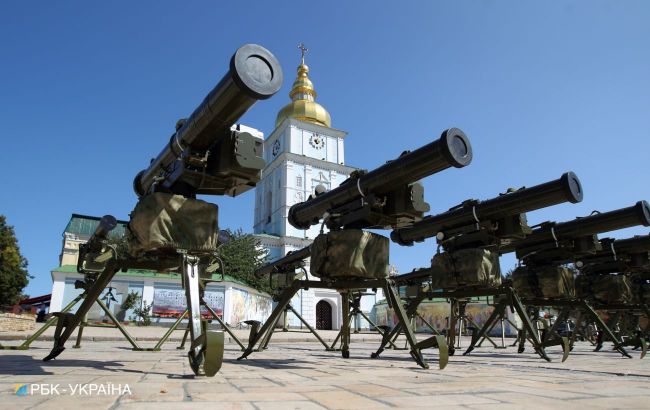What is known about Ukraine's Stugna-P anti-tank missile system: Top advantages over Javelin
 Photo: Stugna-P anti-tank systems at an exhibition in Kyiv (Vitalii Nosach, RBC-Ukraine)
Photo: Stugna-P anti-tank systems at an exhibition in Kyiv (Vitalii Nosach, RBC-Ukraine)
Ukraine has ramped up the production of its indigenous anti-tank missile systems, codenamed Stugna-P. These highly versatile missile complexes have found widespread application on the fronts of the Russia-Ukraine war and are reportedly proving to be on par, if not surpassing, their American counterpart, the Javelin system.
Detailed specifications and a comparison between the Stugna and the American Javelin systems can be found in the following RBC-Ukraine article.
The announcement of this production expansion was made recently by the Minister for Strategic Industries, Oleksandr Kamyshin. While precise production figures were not disclosed, he highlighted significant growth compared to January 2023.
"In July, we produced four times more Stugna missiles than we did in January. And we are continuing to scale up our production efforts. No matter how much we produce now, it will still not be enough," he said
Information on the annual output of the Stugna-P anti-tank missile system is not available in public sources. For instance, in 2018, UkrOboronProm (state manufacturer of weapons and military hardware in Ukraine) supplied over 2,500 units of precision weaponry, though this includes not only Stugna but also other missile systems like Korsar, Barrier, and Vilha.
What is known about Stugna-P
The Stugna-P is an advanced anti-tank missile system developed by the Kyiv-based Luch design bureau. It represents the second generation of anti-tank missile systems.
Capable of firing missiles with calibers of 130 or 152 mm, each equipped with various warhead configurations, the Stugna-P is mounted within a container. The operator has the ability to remotely control the system from a console situated up to 50 meters away.
The basis for the Stugna-P was established on the platform of the guided missile anti-tank system named Stugna. This 100 mm caliber missile was designed for modernizing T-55 tanks and MT-12 Rapira guns.
Development of the anti-tank missile system commenced in 2005, with the Stugna-P missiles featuring a larger 130 mm caliber. The system was officially adopted for military use in 2011.
Mass production was initiated in 2015. In the same year, the Armed Forces and the National Guard received a mobile Stugna-P complex based on the CFmoto Tracker 800 all-terrain vehicle. Starting from 2018, Turkish thermal imagers from Aselsan Eye-Lr S were integrated into the Stugna-P system.
The primary objective of the Stugna-P anti-tank missile system is to effectively neutralize tanks and other armored targets, including those equipped with modern dynamic protection systems.
Key features
The basic version of the system consists of a tripod-mounted launcher, rocket container, guidance device, and remote control unit.
The missiles can be equipped with various types of warheads, including tandem cumulative, fragmentation-high-explosive, and thermobaric. The tandem cumulative warhead (RK-2S) boasts an armor penetration capability of up to 800mm, while the fragmentation-high-explosive variant (RK-2OF) can penetrate up to 60mm of armor. The system's cost starts at $20,000.
The guidance system is semi-automatic and employs a laser beam. Additionally, the missile can be remotely controlled via a television channel from a concealed position.
There are two types of guidance devices available. The Ukrainian PN-I has a target detection range of up to 6,500 meters during daylight hours, with a recognition range of 2,500 meters. The Turkish Aselsan Eye-Lr, on the other hand, boasts daytime target detection at distances of up to 15,000 meters and nighttime detection at 5,600 meters. Human targets can be detected at night up to 2,500 meters.
To facilitate operations in low visibility and nighttime conditions, the system can be equipped with the British thermal imager SLX-Hawk.
Other technical specifications
- Maximum firing range: 5,000 meters
- Maximum nighttime firing range: 3,000 meters
- Flight time to maximum range: 25 seconds or less
- Temperature range for operation: -40°C to +60°C
- Rocket weight in a container: 29.5 kg
- Container length: 1360 mm
- Container external diameter: 140 mm
- Launcher weight: 32 kg
- Guidance device weight: 15 kg
- Remote control unit weight: 10 kg
- Thermal insulation module weight: 6 kg
The export variant of the system is named Skif. Countries operating the Stugna-P system include Azerbaijan, Algeria, Georgia, Myanmar, Morocco, Saudi Arabia, Qatar, Egypt, Jordan, and Türkiye.
Operational mechanism
The missile features a thermal imaging seeker head with an infrared sensor operating in the 8-14 μm range. Operators can simply align the device, and the electronic image of the target and surroundings is relayed to the seeker's head. Upon target acquisition on the monitor, the operator initiates the launch sequence.
When it comes to engaging moving targets, operators of the "Stugna-P" anti-tank guided missile system face a crucial challenge: maintaining the target in their sights while avoiding any movement or reloading of the launcher to ensure uninterrupted targeting.
Practical applications have revealed that beyond its primary role against tanks and armored vehicles, the Stugna-P has demonstrated its capability to engage both static and maneuvering airborne targets, including helicopters. Notably, Ukrainian forces have successfully neutralized several Russian Ka-52 Alligator helicopters using the system.
Stugna-P vs. Javelin: What is better
According to Minister Oleksandr Kamyshin, the Stugna-P surpasses the Javelin in all technical parameters.
"Javelin is a very good product. But we will systematically work to increase the production of our own product and later 'fight' for our product to be properly represented on foreign markets," he said to Ukrainian TV.
Indeed, the Ukrainian Stugna-P outperforms its American counterpart in terms of firing range and soldier safety. The Stugna-P boasts an impressive firing range of up to 5,000 meters, while the FGM-148 Javelin's range is only half of that, at 2,500 meters.
An important advantage of the Ukrainian anti-tank missile system lies in its remote control capability. This feature allows operators to remain concealed and safe while executing combat missions. The launcher's ability to be positioned up to 50 meters away from the operator makes it challenging for adversaries to pinpoint the operator's location. On the other hand, the Javelin is lighter and doesn't require a tripod, providing greater mobility as an "all-in-one" solution.
The Javelin employs an infrared seeker head and a "fire-and-forget" system. After target acquisition and launch, the operator can immediately change positions. The Javelin guarantees tank destruction by targeting the least protected part, such as the turret or the warmest area.
In contrast, operating the Stugna-P requires the operator to keep the target in the crosshairs until the missile hits. Additionally, Javelin's tactic of targeting from above is more effective. The Ukrainian system, however, targets the frontal or side projections, boasting armor penetration of up to 800 mm compared to the Javelin.
However, the Stugna-P offers the "hill" maneuver, allowing the operator to direct the guidance laser not directly at the tank but slightly above it. This technique ensures the missile approaches the target from above, minimizing the risk of the enemy's sensors detecting the laser and the crew evacuating in time.
That is how in the video below, the Stugna-P destroys 4 Russian tanks at once in just three minutes.
Ultimately, the Stugna-P holds another significant advantage: cost. As early as the beginning of 2022, Forbes, citing military experts, wrote that Ukrainian missiles fly farther, with impressive precision, and cost significantly less. Estimated figures indicated approximately $20,000 for the Stugna-P compared to $100,000 for the Javelin.

